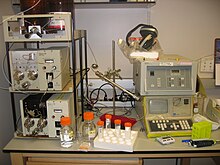High performance liquid chromatography

An HPLC. From left to right: A pumping device generating a gradient of two different solvents- a steel-enforced column and a detector for measuring the absorbance.
|
|
| Acronym | HPLC |
|---|---|
| Classification | Chromatography |
| Analytes |
organic molecules biomolecules ions polymers |
| Other techniques | |
| Related |
Chromatography Aqueous normal-phase chromatography Hydrophilic Interaction Chromatography Ion exchange chromatography Size exclusion chromatography Micellar liquid chromatography |
| Hyphenated | Liquid chromatography-mass spectrometry |
High-performance liquid chromatography (HPLC; formerly referred to as high-pressure liquid chromatography), is a technique in analytical chemistry used to separate, identify, and quantify each component in a mixture. It relies on pumps to pass a pressurized liquid solvent containing the sample mixture through a column filled with a solid adsorbent material. Each component in the sample interacts slightly differently with the adsorbent material, causing different flow rates for the different components and leading to the separation of the components as they flow out the column.
HPLC has been used for manufacturing (e.g. during the production process of pharmaceutical and biological products), legal (e.g. detecting performance enhancement drugs in urine), research (e.g. separating the components of a complex biological sample, or of similar synthetic chemicals from each other), and medical (e.g. detecting vitamin D levels in blood serum) purposes.
Chromatography can be described as a mass transfer process involving adsorption. HPLC relies on pumps to pass a pressurized liquid and a sample mixture through a column filled with adsorbent, leading to the separation of the sample components. The active component of the column, the adsorbent, is typically a granular material made of solid particles (e.g. silica, polymers, etc.), 2–50 micrometers in size. The components of the sample mixture are separated from each other due to their different degrees of interaction with the adsorbent particles. The pressurized liquid is typically a mixture of solvents (e.g. water, acetonitrile and/or methanol) and is referred to as a "mobile phase". Its composition and temperature play a major role in the separation process by influencing the interactions taking place between sample components and adsorbent. These interactions are physical in nature, such as hydrophobic (dispersive), dipole–dipole and ionic, most often a combination.
HPLC is distinguished from traditional ("low pressure") liquid chromatography because operational pressures are significantly higher (50–350 bar), while ordinary liquid chromatography typically relies on the force of gravity to pass the mobile phase through the column. Due to the small sample amount separated in analytical HPLC, typical column dimensions are 2.1–4.6 mm diameter, and 30–250 mm length. Also HPLC columns are made with smaller sorbent particles (2–50 micrometer in average particle size). This gives HPLC superior resolving power (the ability to distinguish between compounds) when separating mixtures, which makes it a popular chromatographic technique.
...
Wikipedia
